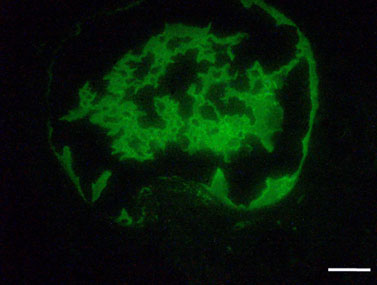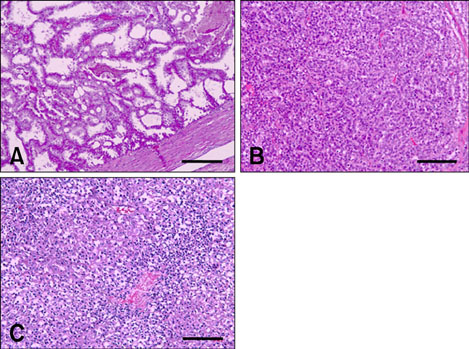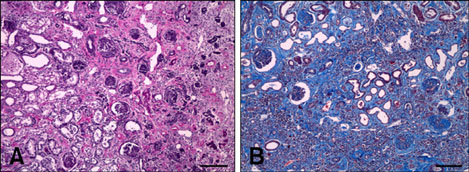J Vet Sci.
2010 Dec;11(4):277-283. 10.4142/jvs.2010.11.4.277.
Histopathological retrospective study of canine renal disease in Korea, 2003~2008
- Affiliations
-
- 1Department of Veterinary Pathology, Small Animal Tumor Diagnostic Center, College of Veterinary Medicine, Konkuk University, Seoul 143-701, Korea. jsur@konkuk.ac.kr
- 2Hyu Animal Clinic, Jeollabuk-do, Iksan 570-973, Korea.
- KMID: 1072175
- DOI: http://doi.org/10.4142/jvs.2010.11.4.277
Abstract
- Renal disease includes conditions affecting the glomeruli, tubules, interstitium, pelvis, and vasculature. Diseases of the kidney include glomerular diseases, diseases of the tubules and interstitium, diseases of renal pelvis, and developmental abnormalities. Renal tissue samples (n = 70) submitted to the Department of Veterinary Pathology of Konkuk University from 2003 to 2008 were included in this study. Tissue histopathology was performed using light microscopy with hematoxylin and eosin stains. Masson's trichrome, Congo Red, and Warthin starry silver staining were applied in several individual cases. Glomerular diseases (22.9%), tubulointerstitial diseases (8.6%), neoplastic diseases (8.6%), conditions secondary to urinary obstruction (24.3%), and other diseases (35.7%) were identified. Glomerulonephritis (GN) cases were classified as acute proliferative GN (5.7%), membranous GN (4.3%), membranoproliferative GN (4.3%), focal segmental GN (2.9%), and other GN (4.2%). The proportion of canine GN cases presently identified was not as high as the proportions identified in human studies. Conversely, urinary obstruction and end-stage renal disease cases were relatively higher in dogs than in human populations.
Keyword
MeSH Terms
Figure
Reference
-
1. Aresu L, Pregel P, Bollo E, Palmerini D, Sereno A, Valenza F. Immunofluorescence staining for the detection of immunoglobulins and complement (C3) in dogs with renal disease. Vet Rec. 2008. 163:679–682.2. Brown CA, Jeong KS, Poppenga RH, Puschner B, Miller DM, Ellis AE, Kang KI, Sum S, Cistola AM, Brown SA. Outbreaks of renal failure associated with melamine and cyanuric acid in dogs and cats in 2004 and 2007. J Vet Diagn Invest. 2007. 19:525–531.
Article3. Bryan JN, Henry CJ, Turnquist SE, Tyler JW, Liptak JM, Rizzo SA, Sfiligoi G, Steinberg SJ, Smith AN, Jackson T. Primary renal neoplasia of dogs. J Vet Intern Med. 2006. 20:1155–1160.
Article4. Choi IJ, Jeong HJ, Han DS, Lee JS, Lee HY, Kim PK. An analysis of 2361 cases of renal biopsy in Korea. Yonsei Med J. 1991. 32:9–15.
Article5. Cotran RS, Kumar V, Collins T, Robbins SL. Robbins Pathologic Basis of Disease. 1999. 6th ed. Philadelphia: Saunders;930–996.6. Gesualdo L, Di Palma AM, Morrone LF, Strippoli GF, Schena FP. The Italian experience of the national registry of renal biopsies. Kidney Int. 2004. 66:890–894.
Article7. Jones TC, Hunt RD, King NW. Veterinary Pathology. 1997. 6th ed. Baltimore: Williams & Wilkins;1111–1147.8. Khoo JJ. Renal biopsies in Johor: a 7-year study. Malays J Pathol. 2001. 23:101–104.9. Macdougall DF, Cook T, Steward AP, Cattell V. Canine chronic renal disease: prevalence and types of glomerulonephritis in the dog. Kidney Int. 1986. 29:1144–1151.
Article10. Monlux AW. The histopathology of nephritis of the dog. I. Introduction. II. Inflammatory interstital diseases. Am J Vet Res. 1953. 14:425–439.11. Mousa DH, Al-Hawas FA, Al-Sulaiman MH, Al-Khader AA. A prospective study of renal biopsies performed over one-year at the Riyadh Armed Forces Hospital. Saudi J Kidney Dis Transpl. 2000. 11:449–454.12. Nielsen SW. Moulton JE, editor. Tumors of the urinary system. Tumors in Domestic Animals. 1990. 3rd ed. Berkeley: University of California Press;458–478.13. Prophet EB, Mills B, Arrington JB, Sobin LH. Laboratory Methods in Histotechnology. 1992. Washington DC: American Registry of Pathology;132–214.14. Ross SJ, Osborne CA, Lulich JP, Polzin DJ, Ulrich LK, Koehler LA, Bird KA, Swanson LL. Canine and feline nephrolithiasis. Epidemiology, detection, and management. Vet Clin North Am Small Anim Pract. 1999. 29:231–250.15. Rychlík I, Jancová E, Tesar V, Kolsky A, Lácha J, Stejskal J, Stejskalová A, Dusek J, Herout V. The Czech registry of renal biopsies. Occurrence of renal diseases in the years 1994-2000. Nephrol Dial Transplant. 2004. 19:3040–3049.
Article16. Vaden SL, Levine J, Breitschwerdt EB. A retrospective case-control of acute renal failure in 99 dogs. J Vet Intern Med. 1997. 11:58–64.
Article17. Vaden SL, Levine JF, Lees GE, Groman RP, Grauer GF, Forrester SD. Renal biopsy: a retrospective study of methods and complications in 283 dogs and 65 cats. J Vet Intern Med. 2005. 19:794–801.
Article18. Vilafranca M, Wohlsein P, Trautwein G, Leopold-Temmler B, Nolte I. Histological and immunohistological classification of canine glomerular disease. Zentralbl Veterinarmed A. 1994. 41:599–610.
Article19. Yhee JY, Brown CA, Yu CH, Kim JH, Poppenga R, Sur JH. Retrospective study of melamine/cyanuric acid-induced renal failure in dogs in Korea between 2003 and 2004. Vet Pathol. 2009. 46:348–354.
Article20. Yhee JY, Yu CH, Kim JH, Sur JH. Effects of T lymphocytes, interleukin-1, and interleukin-6 on renal fibrosis in canine end-stage renal disease. J Vet Diagn Invest. 2008. 20:585–592.
Article
- Full Text Links
- Actions
-
Cited
- CITED
-
- Close
- Share
- Similar articles
-
- Power Doppler Imaging in Acute Renal Vein Occlusion and Recanalization: a Canine Model
- Characterization of canine oral papillomavirus by histopathological and genetic analysis in Korea
- Differential approaches in the maloclusion with canine impaction
- Complications of Teeth and Implants Adjacent to Canine Implants: A Retrospective Study
- Assessment of the permanent canine bone support after secondary bone graft in UCLP patients







